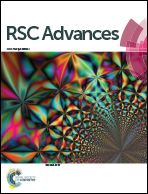High performance anion exchange ionomer for anion exchange membrane fuel cells
Abstract
The anion exchange ionomer incorporated into the electrodes of an anion exchange membrane fuel cell (AEMFC) enhances anion transport in the catalyst layer of the electrode, and thus improves performance and durability of the AEMFC. In this work, a novel ionomer based on a triblock copolymer with high conductivity and good durability is synthesized successfully. The spectroscopy (such as 1H-NMR, FT-IR) results of the ionomer indicate that the functional group is grafted onto the poly(styrene-ethylene/butylene-styrene) (SEBS) successfully and the OH− conductivity of the ionomer is 30 mS cm−1 at 75 °C. Besides, quaternary ammonium SEBS (QASEBS) is used as the ionomer in a H2/O2 AEMFC and exhibits a significant durability of 500 h at a constant current density of 100 mA cm−2, moreover, the degradation rate of voltage is only 0.22 mV h−1 during the 500 h durability test. In addition, the peak power density of the membrane electrode assembly (MEA) with the QASEBS ionomer reaches 375 mW cm−2 at 50 °C, which is 3 times than that of the MEA using the commercially available Acta I2 ionomer (124 mW cm−2) for comparison.



 Please wait while we load your content...
Please wait while we load your content...